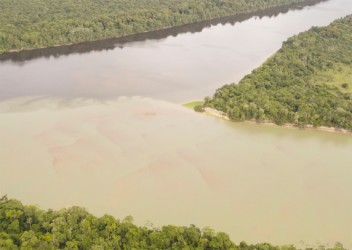“Iwokrama’s mission is to develop strategies for conservation and sustainable development of the tropical rain forest system for local people in Guyana and the world at large. Come visit us in the Rain Forest or at our office, 77 High Street, Kingston, Georgetown. We are online: http://www.iwokrama.org. Also check for updates on our Facebook Page: https:// www.facebook.com/#!/IwokramaInternationalCentre
Apoteri Village in Region 9 sits at the confluence of the Rupununi and Essequibo rivers. Here you can see the dramatic “meeting of waters” where the white water of the Rupununi and black water of the Essequibo merge.
Guyana’s largest river, the Essequibo, is commonly referred to as a black water river. The tea-coloured

appearance of the water is a result of tannins seeped out of leaves from the forest that border the great river, and the water remains this colour as the river bottom is made up of rock and sand. The white or milky colour of the Rupununi River is due to the clay and soil that form the river bed, which then washes into the river and changes the tannin/tea colour to white.
The Iwokrama River Lodge and Research Centre is situated near the Kurupukari Landing on the bank of the Essequibo River. This is just a small part of the Iwokrama Rain Forest which covers 371,000 hectares (one million acres) of tropical forest in the heart of Guyana.





